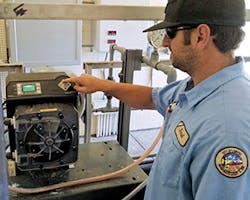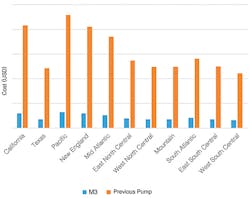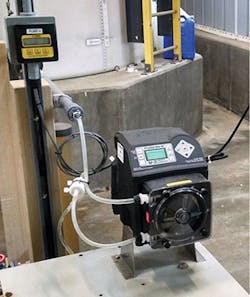MANY WATER TREATMENT PLANT UPGRADES and purchasing decisions are entirely determined by price. However, long-term costs, such as energy and maintenance, are often not considered in the initial stages. This potentially leaves water treatment plants with ongoing and reoccurring expenses that could result in higher energy bills, increased purchases of spare parts, and operator labor time.
The City of Lompoc Water Treatment Plant analyzed the long-term potential cost savings of taking these ongoing expenses into consideration, and they’re already seeing the payback as a result.
The plant, located in Lompoc, CA, treats approximately 3 million gallons of water per day (mgd) during the low-demand season and 4.5 mgd during the high-demand season. The plant
currently has 1,019 active service connections in its distribution system, servicing approximately 43,500 residents.
The city had been operating its chlorine injection process with a system that was over 10 years old. After a recent multi-point failure in its chlorine injection system, which caused an overdose, an in-depth evaluation of its process was performed. A failure of ancillary items allowed for the chemical to be gravity fed into the system causing this overdose.
After analyzing where the failures occurred, the utility decided to switch to a more advanced and more cost-effective product. The plant operators were looking to reduce power consumption, simplify maintenance, increase reliability, enhance flow control, simplify SCADA interface, and remove ancillary items in their system. By switching to Blue-White Proseries-M M-3 peristaltic pumps, they were able to achieve these goals.
Prior to the purchase of the new chemical metering pumps, the plant was using diaphragm pumps, which were driven by a single-horsepower motor. In order to reduce the power consumption of the chemical metering pump, the City of Lompoc chose Blue-White peristaltic metering pumps, which use a highly efficient, one-fourth-horsepower, three-phase brushless DC motor. Operating on 115VAC voltage source with a max amperage draw of 13.6A, the single-horsepower diaphragm pumps were consuming approximately 1,564 watts of power. This resulted in energy costs of approximately $2,075 per year.
The M-3 peristaltic pump operates on the same 115VAC power source, but has a maximum amperage draw of 1.913A and consumes approximately 220 watts, leading to an estimated energy cost of $300 per year. This results in savings to the plant of nearly $1,775, or 710%, in energy costs. The payback on the M-3 pump is achieved in less than two and a half years. The data provided is based on California rates, and energy costs will vary depending on locations within the US (as shown in Table 1). However, the percentage of savings will remain constant.
The amperage draw of each pump can vary with the change of pressures and outputs, as the load on the motor will cause it to draw more or less depending on the application. For example, using a soft material tube operating at approximately 13% motor speed, the onsite amp draw was measured at 0.1A.
While energy costs played a key role in determining which pump to purchase, maintenance costs were also considered. Unlike diaphragm pumps, check valves are not required for peristaltic pumps in order to prevent backflow or siphoning. Chemicals that contain particulates or calcify are detrimental to diaphragm pumps, as valves can become clogged. This leads to ongoing maintenance requirements and expenses including cleaning, replacement of parts, or even a pump failure. However, peristaltic pumps rely solely on the pinch of the pump tube to prevent this unwanted backflow or siphoning. The compression of the tube also enables the pump to move particles through the fluid path.
Although the tube is a wearable item, a periodic tube change is the only ongoing maintenance requirement for the pump. This procedure can be completed in less than five minutes.
The City of Lompoc is currently using an NKL tube, which costs less than $60. The minimal maintenance requirement enables operators to focus their time and effort in other areas of the operation, which is a valuable cost savings.
In addition to reducing maintenance costs, the plant simplified its process by removing ancillary items. The back pressure and air relief valves were removed from the sodium hypochlorite system because peristaltic pumps do not require them for operation. Since diaphragm pumps lose output when pumping against pressure, a back pressure valve is a common item used to maintain a consistent output as system pressures can vary. This can result in a fluctuation in chemical dosing. By comparison to a diaphragm pump, the M-3 does not lose output against pressure; the compression and rotation of the roller against the tube positively displaces the fluid.
Diaphragm pumps are also prone to vapor locking, especially when exposed to gaseous chemicals such as sodium hypochlorite. Because there is no vapor-lock condition, air or gas relief valves are not required on the M-3 pump. The M-3 is able to move trapped gases through the fluid path.
While the M-3 can be used in various applications, it was specifically designed for use in municipal water and wastewater treatment applications.
Water treatment plants rarely mimic the process from one plant to another. This was considered when the M-3 was in its initial design phase. So, using one standard pump head size, the M-3 allows for 12 interchangeable tube options, and provides exceptional chemical compatibility with those chemicals commonly used to treat water and wastewater.
Because of its versatility, low-maintenance costs, advanced motor technology, SCADA interface, and reduced power consumption, the M-3 peristaltic pump has proven to be an excellent choice for the City of Lompoc.


